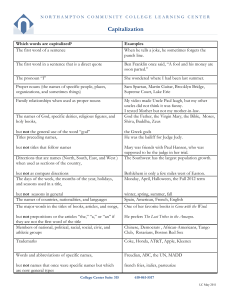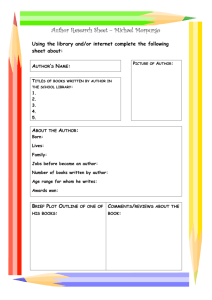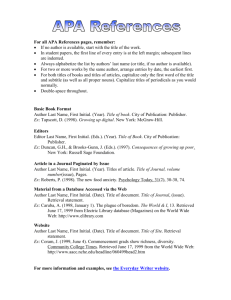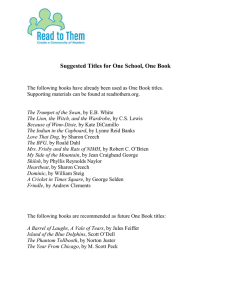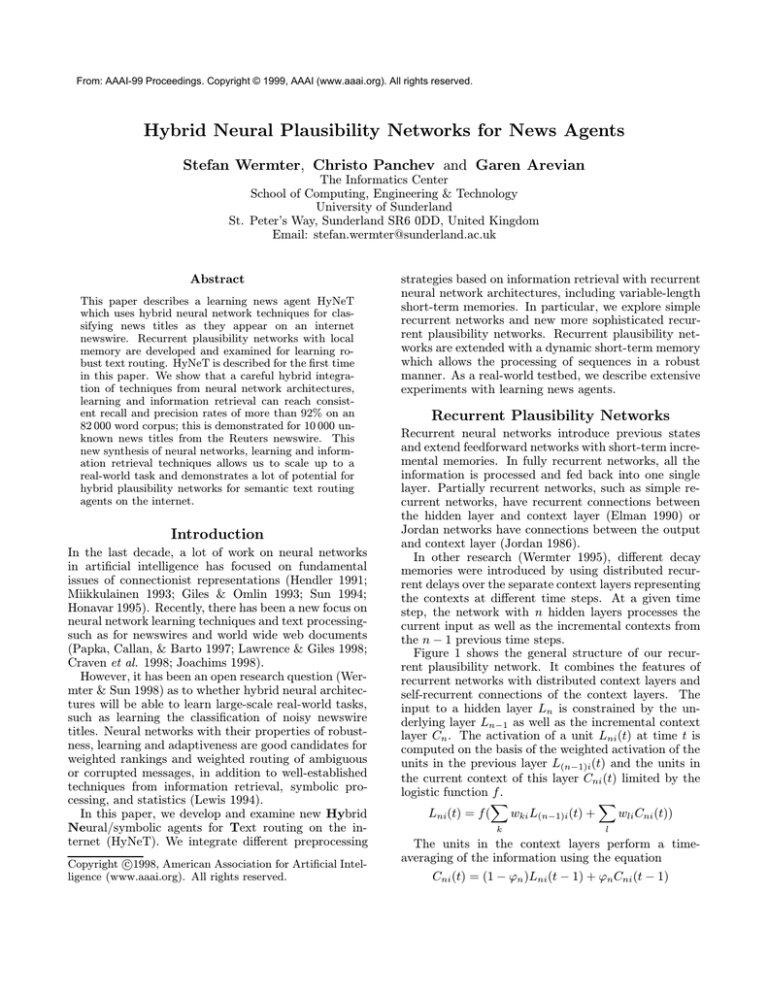
From: AAAI-99 Proceedings. Copyright © 1999, AAAI (www.aaai.org). All rights reserved.
Hybrid Neural Plausibility Networks for News Agents
Stefan Wermter, Christo Panchev and Garen Arevian
The Informatics Center
School of Computing, Engineering & Technology
University of Sunderland
St. Peter’s Way, Sunderland SR6 0DD, United Kingdom
Email: stefan.wermter@sunderland.ac.uk
Abstract
This paper describes a learning news agent HyNeT
which uses hybrid neural network techniques for classifying news titles as they appear on an internet
newswire. Recurrent plausibility networks with local
memory are developed and examined for learning robust text routing. HyNeT is described for the first time
in this paper. We show that a careful hybrid integration of techniques from neural network architectures,
learning and information retrieval can reach consistent recall and precision rates of more than 92% on an
82 000 word corpus; this is demonstrated for 10 000 unknown news titles from the Reuters newswire. This
new synthesis of neural networks, learning and information retrieval techniques allows us to scale up to a
real-world task and demonstrates a lot of potential for
hybrid plausibility networks for semantic text routing
agents on the internet.
Introduction
In the last decade, a lot of work on neural networks
in artificial intelligence has focused on fundamental
issues of connectionist representations (Hendler 1991;
Miikkulainen 1993; Giles & Omlin 1993; Sun 1994;
Honavar 1995). Recently, there has been a new focus on
neural network learning techniques and text processingsuch as for newswires and world wide web documents
(Papka, Callan, & Barto 1997; Lawrence & Giles 1998;
Craven et al. 1998; Joachims 1998).
However, it has been an open research question (Wermter & Sun 1998) as to whether hybrid neural architectures will be able to learn large-scale real-world tasks,
such as learning the classification of noisy newswire
titles. Neural networks with their properties of robustness, learning and adaptiveness are good candidates for
weighted rankings and weighted routing of ambiguous
or corrupted messages, in addition to well-established
techniques from information retrieval, symbolic processing, and statistics (Lewis 1994).
In this paper, we develop and examine new Hybrid
Neural/symbolic agents for Text routing on the internet (HyNeT). We integrate different preprocessing
c
Copyright 1998,
American Association for Artificial Intelligence (www.aaai.org). All rights reserved.
strategies based on information retrieval with recurrent
neural network architectures, including variable-length
short-term memories. In particular, we explore simple
recurrent networks and new more sophisticated recurrent plausibility networks. Recurrent plausibility networks are extended with a dynamic short-term memory
which allows the processing of sequences in a robust
manner. As a real-world testbed, we describe extensive
experiments with learning news agents.
Recurrent Plausibility Networks
Recurrent neural networks introduce previous states
and extend feedforward networks with short-term incremental memories. In fully recurrent networks, all the
information is processed and fed back into one single
layer. Partially recurrent networks, such as simple recurrent networks, have recurrent connections between
the hidden layer and context layer (Elman 1990) or
Jordan networks have connections between the output
and context layer (Jordan 1986).
In other research (Wermter 1995), different decay
memories were introduced by using distributed recurrent delays over the separate context layers representing
the contexts at different time steps. At a given time
step, the network with n hidden layers processes the
current input as well as the incremental contexts from
the n − 1 previous time steps.
Figure 1 shows the general structure of our recurrent plausibility network. It combines the features of
recurrent networks with distributed context layers and
self-recurrent connections of the context layers. The
input to a hidden layer Ln is constrained by the underlying layer Ln−1 as well as the incremental context
layer Cn . The activation of a unit Lni (t) at time t is
computed on the basis of the weighted activation of the
units in the previous layer L(n−1)i (t) and the units in
the current context of this layer Cni (t) limited by the
logistic function f .
X
X
Lni (t) = f (
wki L(n−1)i (t) +
wli Cni (t))
k
l
The units in the context layers perform a timeaveraging of the information using the equation
Cni (t) = (1 − ϕn )Lni (t − 1) + ϕn Cni (t − 1)
where Cni (t) is the activation of a unit in the context
layer at time t. We represent the self-recurrent connections using the hysteresis value ϕn . The hysteresis
value of the context layer Cn−1 is lower than the hysteresis value of the next context layer Cn . This ensures
that the context layers closer to the input layer will perform as memory that represents a more dynamic context. Having higher hysteresis values, the context layers
closer to the output layer will incrementally build more
stable sequential memory. Therefore the larger context
is built on the more recent, dynamic one.
Output
layer
O(t)
M : N feedforward
connections
1 : 1 recurrent
connections
Hidden
layer
Ln(t)
Context
layer
Cn(t)
Hidden
layer
Ln−1(t)
Cn−1(t)
Input
layer
Context
layer
L I(t)
(t)
0
Figure 1: Recurrent plausibility network.
The Reuters News Corpus
For learning the subtask of text routing, we used
the Reuters text categorization test collection (Lewis
1997). This corpus contains documents which appeared on the Reuters newswire. All news titles in
the Reuters corpus belong to one or more of eight
main categories1: Money/Foreign Exchange (moneyfx, MF), Shipping (ship, SH), Interest Rates (interest, IN), Economic Indicators (economic, EC),
Currency (currency, CR), Corporate (corporate,
CO), Commodity (commodity, CM), Energy (energy, EN).
Examples of typical titles from these categories are
shown in Table 1. As we can see, there are abbreviated phrases or sentences, specific characters, and terms
which would make it difficult to manually encode a tra1
There is also a second level categorization into 135 specific categories, but since we wanted to study the learning
of difficult and possibly ambiguous classifications, we used
the 8 main categories from the first level.
ditional semantic grammar. We can find incompleteness or ambiguity in the category assignments. For
example, the title “U.K. money market offered early
assistance” occurs six times in the corpus belonging to
different semantic categories. Three times it is classified into the “money-fx” category, and three times
into both “money-fx” and “interest” categories. Therefore there is an inherent ambiguity in the corpus and
such examples pose challenges to learning algorithms
and necessarily increase the classification error, since
there is no perfect unambiguous category assignment
in such cases. However, since we wanted to study hybrid neural agents under hard, real-world conditions,
we did not perform any cleaning up of the underlying
corpus data.
We use exactly all 10 733 titles of the so-called ModApte split whose documents have a title and at least
one topic. The total number of words is 82 339 and the
number of different words in the titles is 11 104. For our
training set, we use 1 040 news titles, the first 130 of
each of the 8 categories. All the other 9 693 news titles
are used for testing the generalization to new and unseen examples. The description of this corpus is shown
in Table 2. Since categories may overlap, i.e. one news
title can be in exactly one or several semantic categories, the actual distribution of the titles over the training
set is not even.
Category
money-fx
ship
interest
economic
currency
corporate
commodity
energy
All titles
Training titles
Number Average
length
286
8.26
139
7.04
188
8.79
198
8.43
203
8.54
144
7.10
321
7.35
176
7.80
1 040
7.96
Test titles
Number Average
length
427
8.13
139
7.32
288
8.50
1 099
8.50
92
8.42
6 163
7.43
2 815
7.54
645
8.08
9 693
7.64
Table 2: The distribution of the titles from the Reuters news corpus over the semantic categories. Note
that since one title can be classified in more than one
semantic category, 1 040 titles represent the total number of 1 655 category occurrences for the training set
and 9 693 titles represent the total number of 11 668
category occurrences in the test set.
Hybrid Neural News Routing
In this section, we will describe different architectures
for learning news title classification. Each news title is
presented to the network as a sequence of word input
representations and category output representations,
one such pair for each word. At the beginning of a
news title, the context layers are initialized with 0 values. Each unit in the output layer corresponds to a
particular semantic category. Those output units (one
Semantic Category
money-fx
ship
interest
economic
currency
corporate
commodity
energy
ship&energy
money-fx&interest&currency
Title
Bankers trust issuing STG/DLR currency warrants
U.S. cargo preference squabble continues
Volcker says FED policy not responsible for prime rate rise
German net currency reserves rise 400 mln marks to 87.0 billion - Bundesbank
Stoltenberg not surprised by dollar reaction
First Granite Bancorp Inc agrees to be acquired by Magna Group Inc for stock
Indonesian coffee production may fall this year
U.S. oil dependency seen rising to record level
Kuwait may re-register gulf tankers - Newspaper
J.P. Morgan <JPM> says DLR may prevent FED easing
Table 1: Example titles from the corpus.
or more) which represent the desired semantic categories are set to 1. All other output units are set to 0. We
define a news title as classified to a particular semantic
category if at the end of the sequence the value of the
output unit for the desired category is higher than 0.5.
Using this output classification, we compute the recall
and precision values for each title. These values are
used to compute the average recall and precision rates
for each semantic category, as well as for the overall
training and test sets, which all determine the network
performance.
Supervised learning techniques based on plausibility
networks were used for the training (Rumelhart et al.
1995). The training regime forces the recurrent plausibility network to assign the desired category, starting
from the beginning of the news title as early as possible.
Supervised training is continued until the error over the
training set stops decreasing. Typically, between 700
and 900 epochs through the training set were necessary.
In one epoch, we present all titles from the training set.
Weights were adjusted at the end of each title.
Complete Titles and Significance Vectors
In our first set of experiments, we use significance vectors as the basis for representing words for semantic
category routing. Significance vectors are determined
based on the frequency of a word in different semantic
categories. Each word w is represented with a vector (c1 c2 · · · cn ), where ci represents a certain semantic
category. A value v(w, ci ) is computed for each dimension of the vector as the frequency of occurrences
of word w in semantic category ci (the category frequency), divided by the frequency of occurrences of
word w in the corpus (the corpus frequency). That
is:
F requency of w in ci
v(w, ci ) = P
f or j ∈ {1, · · · n}
F requency f or w in cj
j
The same significance vector can represent two different words if they actually occur with the same frequency across all semantic categories in the whole corpus. However, a news title will be represented by a sequence of significance vectors so that phrases with the
same sequence of significance vectors are less likely. Figure 2 shows the significance vectors of words from the
lexicon. As we can see, words like “mortgage”, “bureau” or “parker” have clear semantic preferences for
specific semantic categories, while domain-independent
words like “a”, “of”, “and” have more distributed preferences.
Word
a
and
bureau
mortgage
of
parker
the
MF
.07
.06
.02
.01
.07
.13
.09
SH
.02
.02
.00
.00
.02
.00
.03
CR
IN
EC
CO CM EN
.04
.17
.04
.28
.27
.10
.03
.15
.03
.25
.34
.09
.00
.38
.02
.02
.56
.01
.30
.18
.00
.51
.00
.00
.03
.14
.03
.28
.31
.09
.00
.00
.13
.73
.00
.00
.05
.18
.05
.20
.31
.09
Figure 2: Examples of significance vectors.
Simple recurrent networks were trained using significance vector representations as the input word representation of the input layer. The performance of the
best trained network in terms of recall and precision is
shown in Table 3. The table contains detailed results for
each semantic category as well as for the whole training
and test sets. The two categories “money-fx” and “economic” are fairly common, which explains their lower
recall and precision rates, but in general, 91.23% recall
and 90.73% precision are reached for the 9 693 unknown
test titles.
Complete Titles and Semantic Vectors
In our second set of experiments, we use a different semantic vector representation of the words in the lexicon.
These vectors mainly represent the plausibility of a particular word occurring in a semantic category and they
are independent of the number of examples observed in
each category. A value v(w, ci ) is computed for each
element of the semantic vector as the normalized frequency of occurrences of word w in semantic category
ci (the normalized category frequency), divided by the
Category
money-fx
ship
interest
economic
currency
corporate
commodity
energy
Total
Training set
recall precision
84.36
84.62
81.06
93.17
77.93
82.71
71.70
80.79
85.75
91.46
88.81
92.31
86.27
94.77
81.88
92.26
85.15
86.99
Test set
recall precision
84.74
69.56
77.34
94.96
85.42
83.45
74.74
77.82
85.36
87.16
94.87
95.10
86.47
88.31
85.22
91.65
91.23
90.73
Table 3: Results using significance vectors
normalized frequency of occurrences of word w in the
corpus (the normalized corpus frequency). That is:
N orm. f req. of w in ci
v(w, ci ) = P
, j ∈ {1, · · · n}
N orm. f req. f or w in cj
j
where:
F req. of w in ci
N umber of titles in ci
Some examples of semantic vectors are shown in Figure 3. As we can see, the domain-independent words
like “a”, “of”, “and” have fairly even distributions,
while the domain-dependent words “bureau”, “parker”
have more specific preferences. An example of the difference between the two types of representation is the
word “mortgage”. Compared to the significance representation, here the preference entirely changes from the
category “corporate” to the category “interest”.
N orm. f req. of w in ci =
Word
a
and
bureau
mortgage
of
parker
the
MF
SH
CR
IN
EC
CO CM EN
.13
.12 .11 .16 .16 .06 .11 .15
.12
.12 .09 .16 .14 .05 .15 .15
.00
.00 .00 .50 .11 .00 .32 .01
.02
.00 .72 .15 .02 .09 .00 .00
.13
.11 .11 .15 .15 .06 .14 .14
.25
.00 .00 .00 .56 .17 .00 .00
.15
.13 .12 .15 .18 .04 .11 .12
Category
money-fx
ship
interest
economic
currency
corporate
commodity
energy
Total
Training set
recall precision
87.78
88.60
81.65
88.13
85.33
86.97
76.22
83.54
87.76
92.59
89.16
91.96
86.27
90.52
89.19
95.48
88.57
88.59
Test set
recall precision
84.07
69.59
82.73
93.88
88.25
88.19
78.36
80.30
89.64
89.86
95.90
95.98
86.20
87.22
86.58
91.56
92.47
91.61
Table 4: Results using semantic vectors
strategy from information retrieval could be useful, one
that emphasizes significant domain-dependent words.
To investigate such a strategy from information retrieval, we removed insignificant words (sometimes also
called “stop words”) from the unrestricted title phrases.
We defined the set of insignificant words as equally frequent, domain-independent words that belong to any
of the following syntactic categories: determiners, prepositions and conjunctions. Using the semantic vector
representation, we extracted a set of 19 insignificant
words of which the difference between the highest and
lowest values in their vector was less than 0.2. For instance, examples of these words are: a, an, and, as, at,
but, by, for, from. These words occur 7 094 times in the
training and test corpus. After removing these words,
the average length of a title in the training set is 7.11
and average length of a title in the test set is 7.00.
The experiment was conducted with the same learning conditions as for the complete unrestricted titles.
The test results are shown in Table 5. We can see
that the removal of insignificant words improves the
recall and precision rates slightly over the last two experiments, but the improvement is small. However, by
removing the insignificant stop words, we have also deleted some domain-independent words; hence this experiment also suggests that noisy corrupted titles can
also be processed.
Figure 3: Examples of semantic vectors
Category
Simple recurrent networks were trained using the
same training parameters and network architecture as
in the previous experiment, but the titles were processed using the semantic vector representations. The
performance of the trained network in terms of recall
and precision is shown in Table 4. Using the semantic
vectors rather than the significance vectors, we improved the test recall and precision rates to 92.47% and
91.61% respectively.
News Titles without Insignificant Words
So far we have examined complete phrases in a simple
recurrent network. However, a symbolic preprocessing
money-fx
ship
interest
economic
currency
corporate
commodity
energy
Total
Training set
recall precision
87.40
89.12
79.14
88.85
86.61
93.09
79.12
87.80
85.55
92.59
89.51
93.71
87.25
91.18
85.32
94.19
88.47
90.05
Test set
recall precision
84.97
69.36
78.42
93.53
88.89
88.77
79.28
82.64
87.39
87.16
96.47
96.48
86.74
86.51
83.86
90.54
92.88
91.92
Table 5: Results without insignificant words
Complete Titles with Plausibility Networks
In this experiment, we use the recurrent plausibility
network described in Figure 1 with two hidden and two
context layers. Different networks have been trained using different combinations of the hysteresis value for the
first and second context layers. The best results were
achieved with the network having a hysteresis value of
0.2 for the first context layer, and 0.8 for the second.
In order to be able to compare the results of this architecture with the previous ones, the rest of the training and testing environment parameters were set to be
the same as in the experiment of the complete titles
with the semantic vector representation of the words.
Table 6 shows the recall and precision rates obtained
with the recurrent plausibility network. There was
an improvement in the classification, especially for the
longer titles, as the two context layers and recurrent
hysteresis connections support a larger and dynamic
short-term memory.
Category
money-fx
ship
interest
economic
currency
corporate
commodity
energy
Total
Training set
recall precision
87.34
89.47
84.65
89.21
85.24
87.77
90.24
91.77
88.89
91.36
92.31
92.66
92.81
93.14
85.27
87.74
89.05
90.24
Test set
recall precision
86.03
76.70
82.37
90.29
88.19
86.05
81.89
83.80
89.64
89.86
95.55
95.43
88.84
90.29
87.69
92.95
93.05
92.29
Table 6: Results using recurrent plausibility network
with semantic vectors
Examples of the Network Output
Figure 4 presents the output representations after
processing three unknown example titles from the test
corpus with the recurrent plausibility network from
the last experiment. Here we show a representative behavior of the network, and in all these examples, the computed final categories are correct. The
first two examples start with the same word sequence
“Bank of Japan”, but later, when a sequence of more
domain-dependent words has been processed, the network changes its output preference according to the semantic meaning of the different input sequences: “intervenes shortly after Tokyo opens” provides a “moneyfx” and “currency” category assignment, while “easy
money policy” leads to an “interest” category assignment. Both these assignments are correct according to
the Reuters classification.
In the third example in Figure 4, we illustrate how
the network, based on the incrementally built context,
can turn the strong output preference from the category
“ship” to “energy”. The network starts with preference for the “ship” and “energy“ categories because, according to all news documents from the corpus, “Iran”
.44
.56
Example (1)
BANK
OF
JAPAN
INTERVENES
SHORTLY
AFTER
TOKYO
OPENS
.11
MF
.65
.58
.74
.97
.98
.96
.97
.96
.22
SH
.33
IN
.48
.40
.21
EC
.19
.20
.23
CR
CO
.36
.30
.60
.97
.98
.95
.96
.95
CM
EN
Example (2)
BANK
OF
JAPAN
DETERMINED
TO
KEEP
EASY
MONEY
POLICY
MF
.65
.58
.74
.15
.26
.22
SH
IN
.48
.40
.21
.56
.50
.31
.94
.92
.90
EC
.19
.20
.23
CR
CO
CM
.36
.30
.60
.18
.14
EN
Example (3)
IRAN
SOVIET
UNION
TO
SWAP
CRUDE
REFINED
PRODUCTS
MF
SH
.72
.90
.97
.95
.92
.69
.23
.15
IN
EC
CR
EN
.57
.35
.20
.19
.26
.84
.98
.96
.17
.43
.67
.78
.89
CO
CM
.16
.22
.14
.20
.34
1.00
Figure 4: Examples and their category preferences
is associated with oil shipping. A recognizable number of news titles in the corpus are about the Soviet
Union commodity crisis and are classified in the “shipping” and “commodity” categories. In the middle of the
title however, when “crude” is processed as a significant
term for the “energy” category, the output preference is
changed to this category and subsequent words confirm
this category assignment.
Discussion
We have described several hybrid neural architectures
for classifying news headlines. In general, the recall and
precision rates for simple recurrent networks and recurrent plausibility networks were fairly high given the degree of ambiguity of title/category and word/category
assignments (for instance, see Table 1). The generalization performance for new and unseen news titles has
been even better than the performance on the training
data (for instance, see experiment 1). This is a very desirable effect and demonstrates that overfitting on the
training set does not exist.
In other related work on text classification, whole
documents rather than titles are often used to classify
a news story. Obviously whole documents contain more
information than titles, but we wanted to examine how
far we can get in terms of classification based only on
the title. However, since a news title contains on average around 8 words, it is unlikely that most of the
words in the sequence are ambiguous and that they
would lead to an incorrect category. Our good recall
and precision results of at least 92% confirm that the
influence of misleading word representations is limited.
Other related work on a different book title classification task using neural networks (Wermter 1995) has
reached 95% recall and precision, but the library titles
are much less ambiguous and only 1 000 test titles have
been used in that approach while we used 10 000 corrupted and ambiguous titles. Also, the titles in our task
are about 25% longer and more difficult to classify.
Our integration of new variations of the vector space
model (significance vectors, semantic vectors) with nonlinear incremental classification from neural networks
was shown as a viable new way for classification and
routing tasks. The removal of insignificant stop words
was shown to provide better results in the simple recurrent network as well. Best results were obtained with a
plausibility network with two hidden layers, two context
layers and recurrent connections for the context layer.
Although the performance was in general fairly high for
different architectures, an additional 2% improvement
in the test set would mean another 200 correctly classified titles. The architecture with plausibility network
has more possibilities to encode the preceding context
and reaches at least 92% minimum value for recall and
precision.
There has been interesting related work on text categorization on the Reuters corpus using whole documents (Joachims 1998). For the ten most frequently occurring categories, the recall/precision breakeven point
was 86% for a Support Vector Machine, 82% for kNearest Neighbor, 72% for Naive Bayes. However, a
different set of categories and whole documents rather
than titles are used and therefore the results are not
directly comparable to ours. Nevertheless, they give
some indication of document classification performance
on this corpus. In particular, for medium text data sets
or when only titles are available, our approach produces
very good performance.
Conclusions
We have described and analyzed HyNeT, a novel news
agent for real-world headline routing which learns to
classify news titles. A neural network architecture with
several context layers and recurrent hysteresis connections is proposed which particularly supports a larger
and dynamic short-term memory. Different from most
related approaches for language processing, we have
used hybrid neural learning techniques.
HyNeT is robust, classifies noisy arbitrary real-world
titles, processes titles incrementally from left to right,
and shows better classification reliability towards the
ends of titles. This synthesis of techniques and constraints from plausibility neural network architectures,
information retrieval and learning holds a lot of potential for building robust hybrid neural architectures of
semantic text routing agents for the internet in the future.
References
Craven, M.; DiPasquo, D.; Freitag, D.; McCallum, A.;
Mitchell, T.; Nigam, K.; and Slattery, S. 1998. Learning to extract symbolic knowledge from the world wide
web. In Proceedings of the 15th National Conference
on Artificial Intelligence.
Elman, J. L. 1990. Finding structure in time. Cognitive Science 14:179–211.
Giles, C. L., and Omlin, C. W. 1993. Extraction, insertion and refinement of symbolic rules in dynamically
driven recurrent neural networks. Connection Science
5:307–337.
Hendler, J.
1991.
Developing hybrid symbolic/connectionist models. In Barnden, J. A., and
Pollack, J. B., eds., Advances in Connectionist and
Neural Computation Theory, Vol.1: High Level Connectionist Models. Norwood, NJ: Ablex Publishing
Corporation. 165–179.
Honavar, V. 1995. Symbolic artificial intelligence and
numeric artificial neural networks: towards a resolution of the dichotomy. In Sun, R., and Bookman, L. A.,
eds., Computational Architectures integrating Neural
and Symbolic Processes. Boston: Kluwer. 351–388.
Joachims, T. 1998. Text categorization with support
vector machines: learning with many relevant features.
In Proceedings of the European Conference on Machine
Learning.
Jordan, M. I. 1986. Attractor dynamics and parallelism in a connectionist sequential machine. In Proceedings of the Eighth Conference of the Cognitive Science
Society, 531–546.
Lawrence, S., and Giles, C. L. 1998. Searching the
world wide web. Science 280.
Lewis, D. D. 1994. A sequential algorithm for training
text classifiers. In Proceedings of the Seventeenth Annual SIGIR Conference on Research and Development
in Information Retrieval.
Lewis, D. D. 1997. Reuters-21578 text categorization
test collection, http://www.research.att.com/ lewis.
Miikkulainen, R. 1993. Subsymbolic Natural Language
Processing. Cambridge, MA: MIT Press.
Papka, R.; Callan, J. P.; and Barto, A. G. 1997.
Text-based information retrieval using exponentiated
gradient descent. In Mozer, M. C.; Jordan, M. I.;
and Petsche, T., eds., Advances in Neural Information
Processing Systems, volume 9, 3. The MIT Press.
Rumelhart, D. E.; Durbin, R.; Golden, R.; and Chauvin, Y. 1995. Backpropagation: the basic theory.
In Chauvin, Y., and Rumelhart, D. E., eds., Backpropagation: theory, architectures and applications.
Hillsdale, NJ: Lawrence Erlbaum Associates. 1–34.
Sun, R. 1994. Integrating Rules and Connectionism for
Robust Commonsense Reasoning. New York: Wiley.
Wermter, S., and Sun, R. 1998. Nips Workshop on Hybrid Neural Symbolic Integration. Breckenridge, CO:
Nips.
Wermter, S. 1995. Hybrid Connectionist Natural Language Processing. London, UK: Chapman and Hall,
Thomson International.

